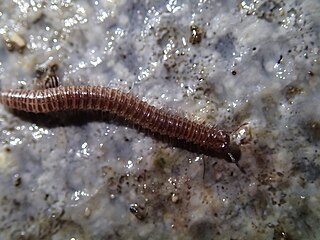
Glomerida is an order of pill-millipedes found primarily in the Northern Hemisphere. Also known as northern pill millipedes, they superficially resemble pill-bugs or woodlice, and can enroll into a protective ball. They have twelve body segments, 17 to 19 pairs of legs, and males have enlarged rear legs involved in mating. The order includes about 30 genera and at least 280 species, including Glomeris marginata, the common European pill-millipede. The order contains members in Europe, South-east Asia and the Americas from California to Guatemala. Although historically considered closely related with the similar sphaerotheriidans that also enroll, some DNA evidence suggest they may be more closely related to glomeridesmidans, a poorly known order that does not enroll.

Polydesmida is the largest order of millipedes, with more than 5,000 species, including all the millipedes reported to produce hydrogen cyanide (HCN). This order is also the most diverse of the millipede orders in terms of morphology. Millipedes in this order are found in all regions of the world other than Antarctica.

Polyzoniida is an order of millipedes in the subterclass Colobognatha. This order contains three families and more than 70 described species. The species in this order are also known as camphor millipedes, because ozopore secretions in this order frequently have a strong camphor-like smell. Poison frogs in South America and Madagascar evidently obtain some of their poison from these millipedes.

Chordeumatida is a large order of millipedes containing more than 1,400 species. Also known as sausage millipedes, they are found nearly worldwide. Chordeumatida is the largest order in the superorder Nematophora, a group also known as spinning millipedes because their telsons feature spinnerets used to build nests of silk. These millipedes produce this silk to create chambers in which to molt or to lay their eggs.

Ammodesmidae is a family of small millipedes endemic to Africa, containing seven species in two genera. Ammodesmids range from 1.4 to 5.0 mm long with 18 or 19 body segments in both sexes, and are capable of rolling into a tight sphere.
Fuhrmannodesmidae is a family of millipedes belonging to the order Polydesmida. Although some authorities deem Fuhrmannodesmidae to be a junior synonym for Trichopolydesmidae, others still regard the taxonomic status of Fuhrmannodesmidae as valid. The family Fuhrmannodesmidae includes over 50 genera.

Anthroleucosomatidae is a family of millipedes in the order Chordeumatida. This family includes more than 100 species distributed among 40 genera. This family has a mostly Holarctic distribution, with the greatest diversity in the area around the Mediterranean sea.

Metopidiotrichidae is a family of millipedes in the order Chordeumatida. This family includes more than 70 species. These millipedes are found in Indochina, Australia, and on Pacific islands from New Zealand to Japan.
Brachychaeteumatidae is a family of millipedes belonging to the order Chordeumatida. Adult millipedes in this family have 30 segments.
Vandeleumatidae is a family of millipedes belonging to the order Chordeumatida. Adult millipedes in this family have 28 or 30 segments.
Apterouridae is a family of millipedes belonging to the order Chordeumatida. Adult millipedes in this family have 30 segments.
Pygmaeosomatidae is a family of millipedes belonging to the order Chordeumatida. Adult millipedes in this family have 30 or 32 segments.
Megalotylidae is a family of millipedes belonging to the order Chordeumatida. Adult millipedes in this family have 28 or 30 segments.
Eudigonidae is a family of millipedes belonging to the order Chordeumatida. Adult millipedes in this family have 30 or 32 segments.
Kirkayakidae is a family of millipedes belonging to the order Chordeumatida. This family was formerly known as Altajellidae. Adult millipedes in this family have 28 segments rather than the 30 segments usually found in chordeumatidans.
Hoffmaneumatidae is a family of millipedes belonging to the order Chordeumatida. This family includes two genera, one (Hoffmaneuma) found in the Russian Far East and the other (Japanoparvus) found in Japan. Millipedes in this family range from 4 mm to 6 mm in length. Adult millipedes in this family have only 28 segments, not the 30 segments usually found in this order. Adult males in this family feature a reduced leg pair 10 in addition to the two pairs normally modified into gonopods in this order. In the adult male of the species Hoffmaneuma exiguum, for example, the gonopod complex derives from all three leg pairs rather than from just the usual two.
Macrochaeteumatidae is a family of millipedes belonging to the order Chordeumatida. Adult millipedes in this family have only 28 segments rather than the 30 segments usually found in this order.
Lusitaniosomatidae is a family of millipedes belonging to the order Chordeumatida. Adult millipedes in this family have 30 segments.
Heterolatzeliidae is a family of millipedes belonging to the order Chordeumatida. Adult millipedes in this family have 30 segments.
Kashmireumatidae is a small family of millipedes belonging to the order Chordeumatida. These millipedes range from 5mm to 14mm in length and are found in East Asia. Adult millipedes in this family have only 26 or 28 segments rather than the 30 segments usually found in this order. In the species Vieteuma topali, adults have 26 segments, whereas in all other species in this family, adults have 28 segments.






